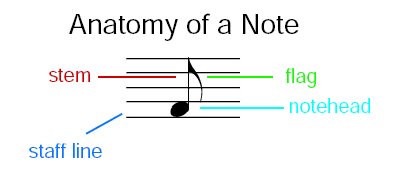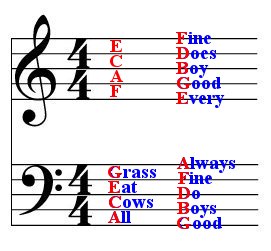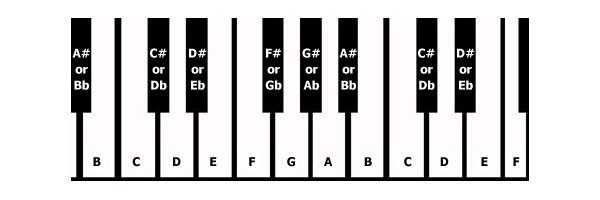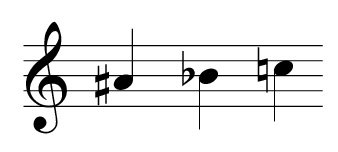Basic Music Notation
Music notation is a language that describes the mechanics of musical performance. The earlist forms of musical notation were marks around the hebrew or greek words to indicate to the cantor or singer what to sing. The problem with this approach was that the singer already had to know the musical components that the marks referenced to be able to sing it. In the same way we have discovered written languages we can read, but cannot now know how to speak out loud, some of our rediscovered ancient music is lost to us as well.
Using modern music notation, it is possible for composers to note with specificity the musical elements that represent the music itself. Just like written English can guide the phonetic pronounciation of its spoken form to someone who does not speak it fluently, music notation can describe the details of music even to someone completely unfamiliar with it. For example, a composer can now describe the exact notes to be sung, along with how loud and long to sing each word and phrase.
Learning to read the notated language of music is not really any harder than learning any other technical jargon and skills. It has unique challenges, but there have been times in history when most educated people could understand and perform the popular music of the day. As long as we continue to teach the basics of reading music, we will never loose our musical heritage again.
Musical Definitions
Notation describes the various definable aspects that make up modern music. The following list summarizes those general aspects.
- Pitch - the primary frequency of a note
- Duration - the length of time a note is held
- Dynamics - the degree of loudness of a note
- Rhythm - the relative time between adjacent notes
- Tempo - the speed at which notes are performed
- Timbre - the quality of a note determined by its overtones
All sounds are vibrations of air. A pitch is the base frequency the vibration of a note occurs. The human ear and brain have the ability to hear the frequency of pitches and classify them based upon their relationships. For example, in the United States, the tuning for the note 'A4' or 'concert pitch' is 440 Hertz (Hz) or pulses per second. When we hear an 'A5' at 880 Hertz we percieve that note as the same as the 'A4' only higher. This relationship of doubled frequencies is called an octave, meaning 8 notes. In music we refer to these 8 notes using the first 8 letters of the English alphabet, A, B, C, D, E, F, G and then A again for the octave note.
Music Notation
Music notation uses symbols to represent the various audible components that make up a song. Since music takes place over a period of time, music is intended to be read like a book.
The staff
The staff is the basic structure of music. It is composed of five parallel lines. The pitch is notated from top to bottom where higher notes are on top and is read over time from left to right. It is divided by bar lines that define measures in the music. The end of a piece of music is marked by a double bar line.

A single staff does not provide enough space to express the full range of human hearing, so a clef symbol is usually present at the beginning of a staff to indicate what part of the scale the staff is intended to cover.
| Clef | Description |
|---|---|
 |
Treble Clef - This is a form of the G-clef where the note G4 is encircled by the curl of the clef. |
 |
Alto Clef - This is a form of the C-clef where middle C passes through the center of the clef. |
 |
Tenor Clef - This is also a form of the C-clef where middle C passes through the center of the clef. Note that the clef is aligned on a different line than the alto clef. |
 |
Tenor Clef - This is the same G-clef as the soprano, but the little "8" on the bottom means the notes in this staff are one octave lower than normal. |
 |
Bass Clef - The bass clef is a form of F-clef where the two dots mark the F on the staff. |

The treble and bass clef staves can be combined to form what is called a grand staff, pictured above. Note the bar lines are joined together and there is a brace on the left side.

For notes that extend above or below the staff, ledger lines are drawn in with the notes.

A note is composed of a notehead with some types of notes including a stem and and a flag.

Here is a friendly reminder for the notes of the lines and spaces on the grand staff.

Here are the notes one octive up and down from middle C.
Time signatures
Time signatures define how many beats there are in each measure marked by bar lines and the value of the note to get one beat.

In a four-four staff, each measure has four beats and the quarter note gets one beat.

In a six-eight staff, each measure has six beats and the eighth note gets one beat.

Six-eight time is often counted in two pulses of three beats each. Three-four time is usually felt in one pulse of three beats each.
Notes and rests
 |
Whole notes and rests |  |
 |
Half notes and rests |  |
 |
Quarter notes and rests |  |
 |
Eighth notes and rests |  |
 |
Sixteenth notes and rests |  |
 |
Thirtysecond notes and rests |  |

| Dotted whole note |  |
| Dotted half note |  |
| Dotted quarter note |  |
| Dotted eighth note |  |
Dynamics
| Marking | Italian | English |
|---|---|---|
 |
Fortississimo | Extremely loud |
 |
Fortissimo | Very loud |
 |
Forte | Loud |
 |
Mezzo-forte | Moderately loud |
 |
Mezzo-piano | Moderately soft |
 |
Piano | Soft |
 |
Pianissimo | Very soft |
 |
Pianississimo | Extremely soft |
Dynamic Indications
| Italian Term | Abbrev. | Definition |
|---|---|---|
| crescendo | cresc. | gradually become louder |
| diminuendo / diminish | dim. | gradually become softer |
Tempo indications
| Italian Term | Abbrev. | Definition |
|---|---|---|
| Accelerando | accel. | accelerate |
| ritard | rit. | slowing down |
| stringendo | string. | accelerate and become louder |
| rallentando | rall. | “winding down” |
| A Tempo | return to tempo or at the tempo | |
| Mosso / moto | motion |
Basic Italian indications
| Italian Term | Definition | poco a poco | little by little (eg. cresc. poco a poco) |
| molto | much, very (eg., molto rit = slow down a lot) |
| con | with (con motto =with motion) |
| più | more (più mosso = more motion) |
| meno | less (meno piano = less soft) |
| morendo | fading away / dying away |
| esspressivo | expressive |
| dolce | sweetly |
| primo | prime/original (primo tempo = at the original tempo) |
Tempo

Key signatures
| Key Signature | Major Key | Minor Key | |||
|---|---|---|---|---|---|
 No sharps or flats |
C major | a minor | |||
| Key Signature | Major Key | Minor Key | Key Signature | Major Key | Minor Key |
 1 sharp |
G major | E minor |  1 flat |
F major | D minor |
 2 sharps |
D major | B minor |  2 flats |
B♭ major | G minor |
 3 sharps |
A major | F♯ minor |  3 flats |
E♭ major | C minor |
 4 sharps |
E major | C♯ minor |  4 flats |
A♭ major | F minor |
 5 sharps |
B major | G♯ minor |  5 flats |
D♭ major | B♭ minor |
 6 sharps |
F♯ major | D♯ minor |  6 flats |
G♭ major | E♭ minor |
 7 sharps |
C♯ major | A♯ minor |  7 flats |
C♭ major | A♭ minor |
Accidentals

